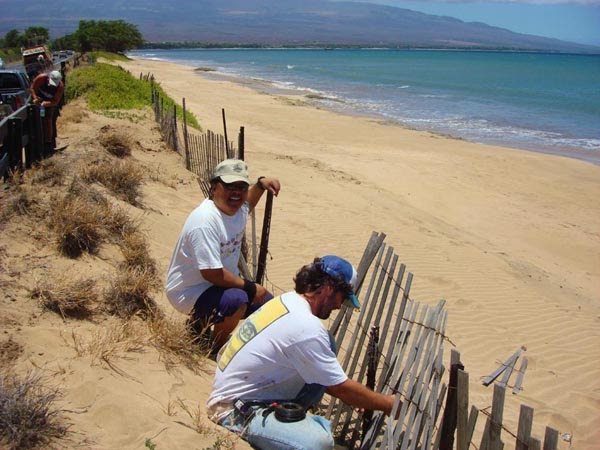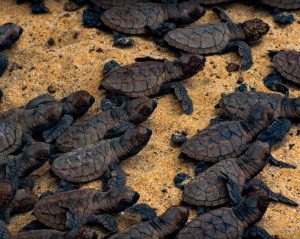Click here for Hawksbill Turtles Part I
You probably have already heard the Hawaiian name for green sea turtles: honu. But did you know that there is actually a difference between green sea turtles and the hawksbill sea turtles in the Hawaiian language?
Honu refers to green sea turtle and honu‘ea, (or simply ‘ea ) refers to hawksbill sea turtles.
In last week’s blog, we explored how the Hawksbill Sea Turtles in Hawai‘i are quite special and need our help to continue a positive population growth.
Honu‘ea Nesting
With nesting season in full swing, 1 June to 30 September, now is the perfect time to learn a bit more about these nesting turtles!
To set a baseline, there are 500 to 800 honu that nest annually in Hawai‘i. Hawaiian honu mainly nest in the remote, northwestern Hawaiian islands, with only a few recorded exceptions.
In contrast, it’s estimated that there are only about 100 nesting female ‘ea. Unlike honu, hawksbill sea turtles nest exclusively on the Main Hawaiian Islands, mostly on Hawai‘i Island and a few on Maui.
Having a much smaller population size and nesting only every 2-7 years on average, successful nesting for honu‘ea is critical for their species’ survival. Typically, honu‘ea lay 1-5 clutches, or groups of eggs, each nesting season. Clutches are laid about 2-3 weeks apart and there are, on average, 180 eggs about the size of a golf ball per clutch.
For ‘ea, incubation lasts for about 2 months. While incubating, the temperature of the nest actually determines the sex of the hatchlings! In a nest, warmer eggs are incubated faster and typically produce female hatchlings. Eggs in cooler places of the nest produce male hatchlings. Hatchlings only weigh around .5 oz or as much as 3 nickels. And by the time they reach adulthood these little guys can weigh up to 300 pounds or about 27,300 nickels…
Once hatchlings leave their nest and make it to the ocean, they sort of….disappear. Not forever, but they are typically not seen or documented in Hawai‘i until they grow to be about the size of a hub cap.
Like many species of sea turtle, ‘ea return to the same beach in which they hatched to lay their eggs.
Risks and Threats to Hatchlings
Honu‘ea are currently listed as critically endangered, after decades of being sought out for their beautiful shells which are used commercially in many types of jewelry and trinkets. While honu‘ea are now federally protected by the Endangered Species Act, both adults and hatchlings still face many threats.
While making their way from their nest to the ocean, coastal lights can be disorientating to young hatchlings, and can ever deter females from nesting at all. In addition, coastal debris can entangle hatchlings or their mothers while making their journey from their nest into the ocean. And, of course, a more obvious threat is predators like dogs and cats that sometimes dig up and destroy nests.
Luckily, there are trained scientists and volunteers who can aid hatchlings in their quest to the ocean.
Conservation Efforts
There are many conservation organizations whose mission is to protect honu‘ea populations. Since 1996, Hawaii Wildlife Fund (HWF) has played a vital role in protecting the small population of hawksbill turtles by researching and monitoring the nesting activities of ‘ea in Hawai‘i.

Image: HWF
In fact, the HWF was formed in response to events in 1993 and 1996 when two egg-laden ‘ea and multiple hatchlings did not make the crossing over North Kihei Road. This began the first systematic research and monitoring of ‘ea on Maui. Thank goodness!
The first fence was constructed in 1998 along turtle nesting habitat by Kealia pond in Kihei. It helps keep turtles from wandering onto the road as well as prevents traffic from driving over buried nests.
HWF also initiated a volunteer beach watch program called “The Dawn Patrol,” but is now a US Fish and Wildlife Service (USFWS) program. During nesting season, volunteers work night and day to monitor known nesting beaches for turtle tracks and nesting mothers. Each nest location is carefully noted from a distance so as not to disturb the laying mother. Additionally, volunteers “turtle sit” the noted nest during the hatching period.
Turtle Guardians
As a native species in Hawaii, sea turtles play an important role in Hawaiian culture, traditions and mo’olelo (stories). Some families continue to revere sea turtles as their ‘aumākua (spiritual guardian). Very fitting as it is now our turn to be their kia’i (guardians).
Mahalo to all the kia’i in our communities who strive to protect and defend these beautiful honu!
Please check in with the USFWS for volunteering options this year as changes may be applicable due to COVID-19.

